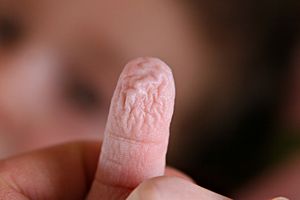Wrinkle facts for kids
A wrinkle is a fold or crease in a smooth surface. You can see wrinkles on skin or fabric. Skin wrinkles often appear as people get older. They can also be caused by how you sleep, losing weight, or sun damage. Sometimes, your skin gets wrinkly if it stays in water for a long time.
Things like making the same facial expressions often, getting older, sun exposure, and not drinking enough water can make wrinkles appear. You can help prevent some wrinkles by staying out of too much sun. Eating healthy foods with vitamins and good fats can also help your skin.
Contents
About Skin Wrinkles
Why Do We Get Wrinkles?
Wrinkles on your face are like small scars on your skin. Imagine your skin has tiny elastic bands and strong ropes called fibers. When you move your face a lot, these fibers can get tiny injuries.
When your body tries to fix these injuries, sometimes the new fibers aren't exactly the same. Some might be too long, making the skin loose. Others might be too short, causing a permanent fold. Over time, these small changes build up, and you see a wrinkle.
Sleep Wrinkles
Sleep wrinkles happen when your face presses against your pillow while you sleep. If you sleep on your side or stomach, your face gets squished. These wrinkles usually appear in certain spots on your face.
They are different from the wrinkles you get from smiling or frowning. Over time, if you keep sleeping in the same position, these sleep wrinkles can become permanent. Changing how you sleep can help stop them from getting deeper.
Wrinkles from Water
Have you ever noticed your fingers and toes get wrinkly after a long bath? People sometimes call this "pruney fingers." This is a temporary change in your skin. Scientists think this might have helped our ancestors. Wrinkly fingers could have given them a better grip on wet things.
For a long time, people thought skin wrinkled just because it soaked up water. But in 1935, scientists found something interesting. They saw that people with certain nerve damage didn't get wrinkly fingers in water. This showed that our nervous system plays a big part.
Now, we know that water makes tiny blood vessels under your skin get narrower. This reduces the fluid under the skin. When the fluid decreases, the skin loses its tightness and becomes wrinkly. This is why it's a good way to check for nerve problems.
Animals with Wrinkles
You can see wrinkles on many animals. Some dog breeds, like the Pug and the Shar Pei, have been bred to have very loose, wrinkly skin. For fighting dogs, loose skin can protect them during a fight.
Young animals often have more loose skin than adults. So, wrinkles can also be a sign of being young.
Ways to Reduce Wrinkles
Many people want to make wrinkles less noticeable as they get older. There are different methods to help with this.
- Creams: Some creams, like those with tretinoin, can help. They work by helping your skin cells renew themselves faster.
- Skin Fillers: These are special gels injected into the skin. They fill in wrinkles and make the skin look smoother. Most fillers use a substance called hyaluronic acid, which is naturally found in the body.
- Botox: This is a medicine injected into specific muscles. It temporarily stops those muscles from moving, which can smooth out wrinkles caused by facial expressions. It's often used for lines between the eyebrows.
- Laser Treatments: Lasers can be used to improve skin. Some lasers remove tiny top layers of skin. Others use light to encourage your skin to make more collagen, which is a protein that keeps skin firm. Laser treatments can make your skin red or swollen for a short time.
See also
 In Spanish: Ritidosis para niños
In Spanish: Ritidosis para niños
- Botulinum toxin
- Injectable filler






